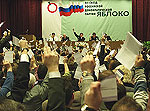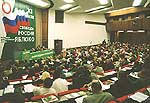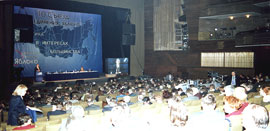The Versailles Trap
Grigory Yavlinsky’s web-site, 13.06.2024
A peace treaty was signed 105 years ago in June 1919 in Versailles, a Parisian suburb, marking the end of World War I. However, the Treaty of Versailles only delivered peace to Europe for a brief moment, before setting the wheels in motion for the start of the even more destructive and bloody World War II. Why did this happen and what lessons must we draw today from events that happened more than a century ago?
PART ONE. BETWEEN TWO WARS
A conference was held in 1945 in Potsdam where the leaders of the USSR, the USA and Great Britain were to determine the future of post-war Germany. A number of decisions were adopted at the conference which were momentous for Europe as a whole, concerning, inter alia, the issues of the demilitarisation and denazification of Germany, post-war borders and the creation of a tribunal to rule on Nazi crimes.

Joseph Stalin, Winston Churchill and Harry S. Truman with their staffs around the conference table at the Potsdam Conference, 17 July 1945 // Wikipedia
One of the principal objectives of the Potsdam Conference was to avoid any repetition of the errors of the Treaty of Versailles of 1919, which had on the one hand heralded the end of World War I, but had on the other hand failed to establish the basis for peace in Europe.
It is a well-known fact that the Treaty of Versailles concluded on 28 June 1919 brought an end to the war between Germany and the anti-German coalition, a war which had led to the loss of over 10 million lives. Eight months earlier the Armistice of 11 November 1918, which had established the cessation of military actions in World War I, had been signed. The decision was adopted not to involve Germany, which had lost the war in every possible aspect, in the elaboration of the peace treaty. Germany was simply presented with a fait accompli: either the country accepted the terms of the Treaty of Versailles, or Germany would be occupied by the armies of the Allies. And Germany’s leadership signed the treaty.

The cover of a publication of the Treaty of Versailles in English. 1919 // Wikipedia
Under the peace treaty, the Germans were held solely responsible for the outbreak of World War I. The empire was broken up into pieces; virtually nothing was left of the formerly powerful German army. The winners compelled Germany to pay astronomical amounts in the form of reparations (as the allies in the anti-German coalition could not even reach agreement on the specific amount, Germany signed to all intents and purposes a blank cheque). As a result of the Treaty of Versailles, the German economy forfeited 16% of the country’s coal industry, 48% of its metal industry and 15% of the country’s agricultural complex.
The Weimar Republic was already bankrupt in 1921. In response France and Belgium occupied the Ruhr area in the west of Germany to offset the shortfall in reparations through the coal and metal enterprises in the region. This was followed by strikes by German workers, hyperinflation and mass unemployment with millions of unemployed throughout Germany. Germans were outraged by the terms of the peace treaty and felt extremely humiliated. Consequently, demand appeared in German society for a national leader who would lead Germany and raise the country from its knees.
Several years passed. In 1933 the parliamentary elections in the Weimar Republic were won by nationalists (National Socialist German Workers’ Party — 43.91% and the German National People’s Party — 7.97%). The electoral programmes of the nationalists contained the following key promises: to return to Germans their national dignity, overcome the economic crisis, eradicate unemployment, unite all ethnic Germans, return the territories lost after World War I and restore the status of Germany as a great power.

Adolf Hitler places his vote in a Königsberg voting booth on March 5, 1933
It is clear that the results of the elections to the Reichstag were predetermined by the terms of the Treaty of Versailles which had sought to ensure peace in Europe, but had instead humiliated the largest nation in Western Europe in terms of population, serving as the pretext for even more horrifying events.
Everyone knows what happened next: six of the most horrific years in the history of mankind — according to various estimates, the loss of 50 million to 75 million lives in World War II, followed by the signing of an act of unconditional surrender by Nazi Germany in May 1945.
It is important to note here that the winners in World War II managed not to fall into the Versailles trap again. And this was confirmed by the results of the Potsdam Conference of 1945. According to the new approach adopted twenty-six years after Versailles, notwithstanding Germany’s evident responsibility for the colossal number of victims in the war, there was no need to humiliate the vanquished people, there was no need to attack the national consciousness, there was no need to disregard the vision that Germans had about the future of their country. An important component of this fundamentally new policy was the Marshall Plan proposed by the USA in 1948, which helped the countries of Western Europe destroyed by the war to recover.

The map of the countries which signed in 1951 the Treaty of Paris and represented the European Coal and Steel Community
It goes without saying that the unquestioning victory of the allies and the unconditional capitulation of Adolf Hitler’s Germany served as the basis for all the decisions adopted after World War II. This is an important factor. However, history never repeats itself. Moreover, the situation today is fundamentally different due to the potential threat of nuclear war. However, as was the case back then, saving human life and the future should also be the number one priority today. This is specifically why such a challenge must be resolved against the backdrop of the changing historical circumstances.
One should also not forget that in 1951 — only six years after the end of the monstrous war in Europe — Belgium, the Netherlands, West Germany, France, Italy and Luxembourg, notwithstanding their numerous differences, laid the foundations for the future European Union, by signing the treaty on the creation of the European Coal and Steel Community. Politicians, who had survived the destructive disaster, understood that a new war could only be avoided by creating a common economy and common rules. And this worked — there have been no armed conflicts between EU countries for 79 years.
PART TWO. PROGRESSION TOWARDS A NEW WAR
1991 — In March the official representatives of the USA, Great Britain, France and Germany agreed in Bonn that NATO membership for East European countries was inadmissible. During the negotiations between Germany, the USA, the USSR, Great Britain and France, the representatives of the West sent a clear message that NATO would not expand and that the alliance could not propose membership to Poland and other countries in Eastern Europe.

German Chancellor Helmut Kohl and Soviet leader Mikhail Gorbachev in Kyiv in 1991 // Frank Darchinger, Spiegel
1992 — Instead of a Russian plan of economic reforms, an American plan was implemented in Russia — “the Washington Consensus”, which resulted in hyperinflation of 2,600% and criminal privatisation. Under the pressure of the International Monetary Fund (IMF) and in exchange for loans, Russia’s leadership rejects the Economic Treaty between Former Republics of the USSR and as a result the decline in production in Russia exceeds 36% in the mid-1990s.
1993 — The USA launches a process for admitting Eastern European countries into NATO, notwithstanding the promises given on the eve of the merger of Germany in 1990 by US President George Bush to the head of the USSR Mikhail Gorbachev. According to these promises, NATO would not advance further than the eastern borders of the united Federal Republic of Germany.
1994 — Russia starts a military campaign in Chechnya. The First Chechen War lasted almost two years. Moreover, the IMF continued financing the Russian economy, assigning the country multibillion dollar loans, with some of the money spent on the war in Chechnya.
1999 — NATO bombs Yugoslavia and introduces a military contingent in Kosovo, thereby interfering in the conflict on the Balkan peninsula where Russia had retained its own strategic interest for centuries.

Vladimir Putin is heading to Russia’s presidential elections in 2000
2000 — Vladimir Putin becomes the Russian President, promising to compensate the Russian people for the humiliations of the 1990s.
2001 — Russia submits a proposal to NATO on the creation of a joint anti-missile ballistic system with the EU and the USA, but receives no response. The USA exits the Treaty on the Limitation of Anti-Ballistic Missile Systems (ABM).
2002 — Russia signs a joint declaration with the USA on new strategic relations which is not implemented at all.
2006 — The USA refuses to ratify the Comprehensive Nuclear-Test-Ban Treaty (CTBT).
2007 — Russian President Vladimir Putin delivers a speech in Munich where he talks clearly about the possibility of a new cold war. Any practical actions to defuse the tensions in relations between Russia and the West should not have been expected after this speech.
2008 — Western countries de facto turn a blind eye to the Russian-Georgian conflict.
2014 — Russia formally incorporates the Republic of Crimea, leveraging the political crisis in Ukraine. Western countries condemn the annexation of the territory and introduce some sanctions against Russia, without proposing any real steps to help prevent an imminent serious crisis.
2015 — Russia suspends its participation in the Treaty on Conventional Armed Forces in Europe (CFE) after a number of Eastern European countries are admitted into NATO.
2019 — The USA exits the Intermediate-Range Nuclear Forces Treaty (INF Treaty).
2020 — The USA exits the Treaty on Open Skies, refuses to extend the Treaty between the United States of America and the Russian Federation on Measures for the Further Reduction and Limitation of Strategic Offensive Arms (New Start Treaty) and announces that it may exit CTBT.

Russian military vehicles move near the Russia-Ukraine border, 26 February 2022 // Michail Voskresensky, RIA Novosti
2022 — Russia starts a special military operation against Ukraine. The leaders of Western countries announce their intention to inflict a “strategic defeat” on Russia and block any negotiations with Russia.
2023 — Russia suspends its participation in the New Start Treaty, exits CFE and revokes its ratification of CTBT.
PART THREE. HUMILIATION AND JUSTICE
Over two years of the special military operation, the armed actions have claimed countless victims, both soldiers and civilians, women and children, and it is not even possible to provide an approximate figure of the number of dead. Millions of people have been forced to abandon their homes. We believe everything that has happened to be a horrific tragedy and have been calling for the immediate conclusion of a ceasefire since the very first day of the special military operation.
Meanwhile the European Union has already introduced 13 packages of anti-Russian sanctions, Russia has been expelled from dozens of international organisations, Russian teams have been excluded and continue to be excluded from participation in sports events at European and global levels, restrictions have been imposed on the entry of Russian citizens into the USA, Canada and countries of the European Union, discriminatory decisions have been adopted against Russians in a number of European countries. Moreover, all the attempts to discuss ways to resolve the Russian-Ukrainian conflict at international forums at different levels are conducted without Russia’s participation, whereas the key Western participants of the events, such as the USA, Great Britain and the European Union, refuse to participate in the organisation of direct ceasefire negotiations, instead preferring to promote further escalation — a continuation and expansion of the bloody conflict. And in actual fact the zone of the military actions is increasing and more and more people are dying.

The Russian flag is removed outside the Council of Europe building, 16 March 2022 in Strasbourg
As was the case one hundred years ago, the world is again moving towards a major war. This must be stopped.
As was the case in Versailles in 1919, so-called international peace conferences are being held today without a key participant in the conflict. Lessons are not being learned from the errors made at Versailles. Owing to ignorance and irresponsibility, people are failing to discern the historical parallels. In actual fact, it was the humiliating and disparaging attitude to a major European country, to a whole nation in the 1910s and 1920s, which played a key role in leading mankind to catastrophe. You should never humiliate anyone in politics — you cannot restore justice through humiliation. Justice has nothing to do with political ambitions, populist whims and even territories. True justice means saving lives and laying a path to the future for children, and preventing the loss of a culture and country as a whole, of an entire nation.
Many important and even fundamental issues between Russia and Ukraine, between Russia and the West can be resolved through diplomacy. They can be resolved over months and even years. The key is to ensure that no more people die during this period. However, this opportunity will only exist if we manage to avoid any further escalation on the path to nuclear confrontation (and such a likelihood increases with every passing day). That is why nothing is more important than an immediate ceasefire between Russia and Ukraine.
However, for the time being we continue veering towards a major war and it would appear that we are once again falling into the same Versailles trap.
Posted: June 14th, 2024 under Foreign policy, History, Human Rights, Russia-Eu relations, Russia-Ukraine relations, Russia-US Relations.






